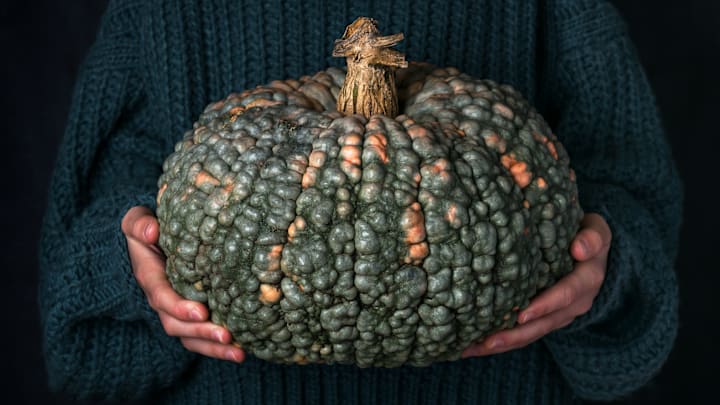For some, autumn doesn’t officially begin until they make their annual trip to the pumpkin patch. Whether you’re selecting a squash for carving or cooking, you may notice that some of them come with noticeable warts. That’s not necessarily a defect—many gourds are bred to look that way.
Though some pumpkins are perfectly smooth, others are sought out for their witch-like warts. Agriculture companies are aware of this and will selectively breed crops to achieve the gnarled look.
Some of these varieties are relatively recent creations. In 2008, Siegers Seed Company in Holland, Michigan, developed a new strain of pumpkins covered in green and orange warts following generations of crossbreeding. They were dubbed knuckleheads. According to Colorado Gardener, the unusual feature isn’t a sign of disease in this case. Rather, the fruit's supercharged sugar production causes its skin to burst and warts to form.
In other instances, bumps and knobs are a sign that a squash is unwell. Four mosaic viruses (viruses that give plants a mottled appearance) affect pumpkins: papaya ringspot virus, zucchini yellow mosaic virus, cucumber mosaic virus, and watermelon mosaic virus. The first two listed cause major deformities, with knobby lumps being a common symptom of the infections. The main vectors of mosaic viruses are aphids, which are typical enemies of gardeners.

Pumpkins can also develop warts due to edema. The physiological condition occurs when the water in a plant doesn’t evaporate fast enough as it absorbs more water through its roots. The excess moisture leads to increased turgor pressure, or the pressure that water exerts against a cell wall, causing the pumpkin’s inner cells to swell. The expansion of the inner cells damages and discolors exterior cells, which leaves the gourd with grayish-brown imperfections.
Even when a pumpkin’s lumps are the result of health issues, they’re still safe to eat most of the time. University of Nebraska food safety educator Carol Larvick told the Nebraska Extension in Dodge County, “The presence of mosaic [virus] won’t cause fruits to rot prematurely, but severely distorted fruit will have a different texture, so use your own judgment.”
Read More About Plants:
